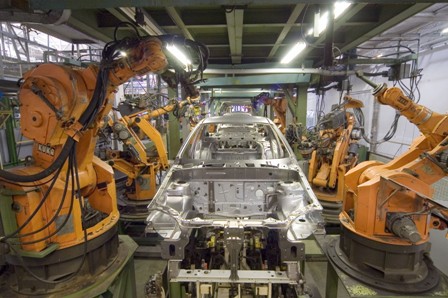By Ashley Little, DO Supply, Inc.
Production lines today are barely recognizable to those created at the beginning of the Industrial Revolution. Automation has continuously changed the face of manufacturing from the first automated assembly line popularized by Henry Ford back in 1913 to the collaborative robots of today which work alongside human teams aiding productivity, quality and safety while also reducing production costs, errors and lead-times for businesses.
Automation has become more complex by utilizing mechanical, electronic, and digital technologies to create intelligent machines and refine production processes. Looking at the roots of automation processes can give a framework for understanding how further developments will impact the future.
 A Quick Look at Automation in the Past
A Quick Look at Automation in the Past
Oliver Evans is credited with the first fully automated industrial process all the way back in 1785. His hydro-powered flour mill required only two men – one to feed the mill with grain at one end, and one to remove the barrels of flour from the other. All other work between was completed by a variety of machines that were connected to the central waterwheel, truly revolutionizing flour production for mass consumption.
Henry Ford’s automated production line in 1913 advanced the concept of automated production lines and introduced the idea of mass production that we are conscious of today. Further advances were made by Japan during and after WW2, and many of the automation devices they developed – including electrical timers, micro-switches, and protective relays – laid the foundations for automation across a wide range of manufacturing industries.
Late in the 20th century, the reduction of the size and cost of computers led to widespread adoption, enabling the implementation of automation across a range of industries from pharmaceuticals to mining and production of nearly every variety. Simultaneously, this decreased the need for human workers in certain positions and increased human-safety in many manufacturing sectors.
Industrial Automation Today
Today we stand at the threshold of the 4th Industrial Revolution, or Industry 4.0. Smart manufacturing, artificial intelligence (AI) and the Internet of Things (IoT) are poised to change the way we produce almost everything.
Large production line robots which work in caged off areas are losing their appeal for manufacturers as their smaller and more adaptable cousins – collaborative robots, or cobots – infiltrate the market and enable manufacturers of all sizes to take advantage of technology for automating production.
This relatively new technology, invented in the mid-1990s, permits users to easily configure their machines via apps, adjust them easily for changes to production lines, or teach them new skills so they can work comfortably alongside human workers rather than being caged off and separated from the rest of the workforce. Cobots have power and force limitations which make them safer for integration into human teams. Additionally, they are equipped with sensors that enable an awareness of their surroundings and reduce the risk of accidents.
The wider range of tasks that cobots can be used for, along with the smaller initial outlay (typically $15,000 – $30,000) and faster return on investment, is driving the increased adoption of the technology across a wider range of industries than any predecessor technology. Within the next 2-3 years it is expected that 70% of SMEs will be using cobots in production.
The Future of Industrial Automation
As the connectivity of devices and machines in IoT networks across the globe increases and technologies such as augmented reality (AR), virtual reality (VR) and 3D printing are further developed and implemented in industrial processes, we will see significant changes in industrial automation.
Already, AR and VR are being used to streamline design processes and provide training and workplace instruction. Over the coming decade, we can expect the physical and digital worlds to converge to create a new reality that connects physical, digital and human experience. AR will revolutionize various industries ranging from engineering to manufacturing and even sales.
3D printing will move the creation of some products from factories to consumer’s homes. Already 98% of hearing aids are made with 3D printing technology. It stands to reason that consumers in the future will download a blue print for their required hearing device and print one of their own without ever needing to visit a store. Nike has been trialing similar technology, allowing athletes to create and print their own personalized running shoes.
AR, VR and 3D printing will change manufacturing as we understand it today, enabling a continuous thread from concept design to create the physical product either at a dedicated factory or within our homes. Not only will these technologies be beneficial in reducing waste and improving our use of resources in the industrial sector, they also may be the driving edge in turning manufacturing into a service industry.







